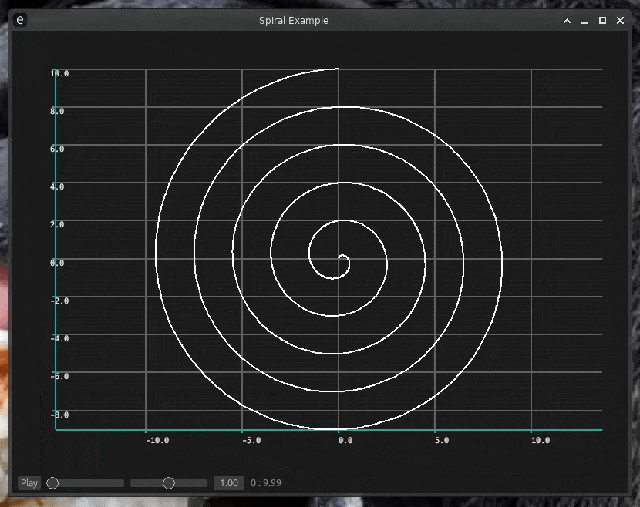6 releases (3 breaking)
Uses new Rust 2024
| 0.4.0 | Mar 8, 2025 |
|---|---|
| 0.3.0 | Jun 25, 2023 |
| 0.2.1 | Jun 18, 2023 |
| 0.1.1 | Jun 12, 2023 |
#153 in GUI
136 downloads per month
65KB
1K
SLoC
egui-plotter
simple to use utilties for integrating plotter into egui
Usage
This crate can be used by adding egui-plotter to the dependencies in your
project's Cargo.toml.
[dependencies]
egui-plotter = "0.3.0"
It is also heavily recommended you disable feathering in your egui context, as not only does it slow things down but it causes artifacts with certain plots.
See line 24 example below to see how to disable feathering.
Features
timechart- Includes all the pre-made animatable charts like XyTimeData and TimeData.
Examples
Here's a simple plotter example being run on native eframe. Derived from eframe and plotters.
use eframe::egui::{self, CentralPanel, Visuals};
use egui_plotter::EguiBackend;
use plotters::prelude::*;
fn main() {
let native_options = eframe::NativeOptions::default();
eframe::run_native(
"Simple Example",
native_options,
Box::new(|cc| Box::new(Simple::new(cc))),
)
.unwrap();
}
struct Simple;
impl Simple {
fn new(cc: &eframe::CreationContext<'_>) -> Self {
// Disable feathering as it causes artifacts
let context = &cc.egui_ctx;
context.tessellation_options_mut(|tess_options| {
tess_options.feathering = false;
});
// Also enable light mode
context.set_visuals(Visuals::light());
Self
}
}
impl eframe::App for Simple {
fn update(&mut self, ctx: &egui::Context, _frame: &mut eframe::Frame) {
CentralPanel::default().show(ctx, |ui| {
let root = EguiBackend::new(ui).into_drawing_area();
root.fill(&WHITE).unwrap();
let mut chart = ChartBuilder::on(&root)
.caption("y=x^2", ("sans-serif", 50).into_font())
.margin(5)
.x_label_area_size(30)
.y_label_area_size(30)
.build_cartesian_2d(-1f32..1f32, -0.1f32..1f32)
.unwrap();
chart.configure_mesh().draw().unwrap();
chart
.draw_series(LineSeries::new(
(-50..=50).map(|x| x as f32 / 50.0).map(|x| (x, x * x)),
&RED,
))
.unwrap()
.label("y = x^2")
.legend(|(x, y)| PathElement::new(vec![(x, y), (x + 20, y)], &RED));
chart
.configure_series_labels()
.background_style(&WHITE.mix(0.8))
.border_style(&BLACK)
.draw()
.unwrap();
root.present().unwrap();
});
}
}
Charts
Alternatively, the above example can be made with a Chart type to allow easy
user interactivity with your plotter charts. You can either make your own chart or
use a prebuilt chart type included in the charts module.
use eframe::egui::{self, CentralPanel, Key, Visuals};
use egui_plotter::{Chart, MouseConfig};
use plotters::prelude::*;
use std::ops::Range;
fn main() {
let native_options = eframe::NativeOptions::default();
eframe::run_native(
"ParaChart Example",
native_options,
Box::new(|cc| Box::new(ParaChart::new(cc))),
)
.unwrap();
}
struct ParaChart {
chart: Chart<(Range<f32>, Range<f32>)>,
}
impl ParaChart {
fn new(cc: &eframe::CreationContext<'_>) -> Self {
// Disable feathering as it causes artifacts
let context = &cc.egui_ctx;
context.tessellation_options_mut(|tess_options| {
tess_options.feathering = false;
});
// Also enable light mode
context.set_visuals(Visuals::light());
// We use data to adjust the range of the chart. This can be useful for
// line plots where the X represents time and we want to play through
// the X, but that is not what we are using it for here
let chart = Chart::new((-3f32..3f32, -0.5f32..3f32))
.mouse(MouseConfig::enabled())
.builder_cb(Box::new(|area, _t, ranges| {
// Build a chart like you would in any other plotter chart.
// The drawing area and ranges are provided by the callback,
// but otherwise everything else is the same.
let (x_range, y_range) = ranges;
let mut chart = ChartBuilder::on(area)
.caption("y=x^2", ("sans-serif", 50).into_font())
.margin(5)
.x_label_area_size(30)
.y_label_area_size(30)
.build_cartesian_2d(x_range.to_owned(), y_range.to_owned())
.unwrap();
chart.configure_mesh().draw().unwrap();
chart
.draw_series(LineSeries::new(
(-50 * (x_range.end as i32)..=(50 * x_range.end as i32))
.map(|x| x as f32 / 50.0)
.map(|x| (x, x * x)),
&RED,
))
.unwrap()
.label("y = x^2")
.legend(|(x, y)| PathElement::new(vec![(x, y), (x + 20, y)], RED));
chart
.configure_series_labels()
.background_style(WHITE.mix(0.8))
.border_style(BLACK)
.draw()
.unwrap();
}));
Self { chart }
}
}
impl eframe::App for ParaChart {
fn update(&mut self, ctx: &egui::Context, _frame: &mut eframe::Frame) {
CentralPanel::default().show(ctx, |ui| {
// Press 1 for the range -1..1, 2 for -2..2, 3 for -3..3
ui.input(|input| {
if input.key_down(Key::Num1) {
*self.chart
.get_data_mut() = (-1f32..1f32, -0.5f32..1f32);
}
if input.key_down(Key::Num2) {
*self.chart
.get_data_mut() = (-2f32..2f32, -0.5f32..2f32);
}
if input.key_down(Key::Num3) {
*self.chart
.get_data_mut() = (-3f32..3f32, -0.5f32..3f32);
}
});
self.chart.draw(ui);
});
}
}
Dependencies
~9–15MB
~193K SLoC

